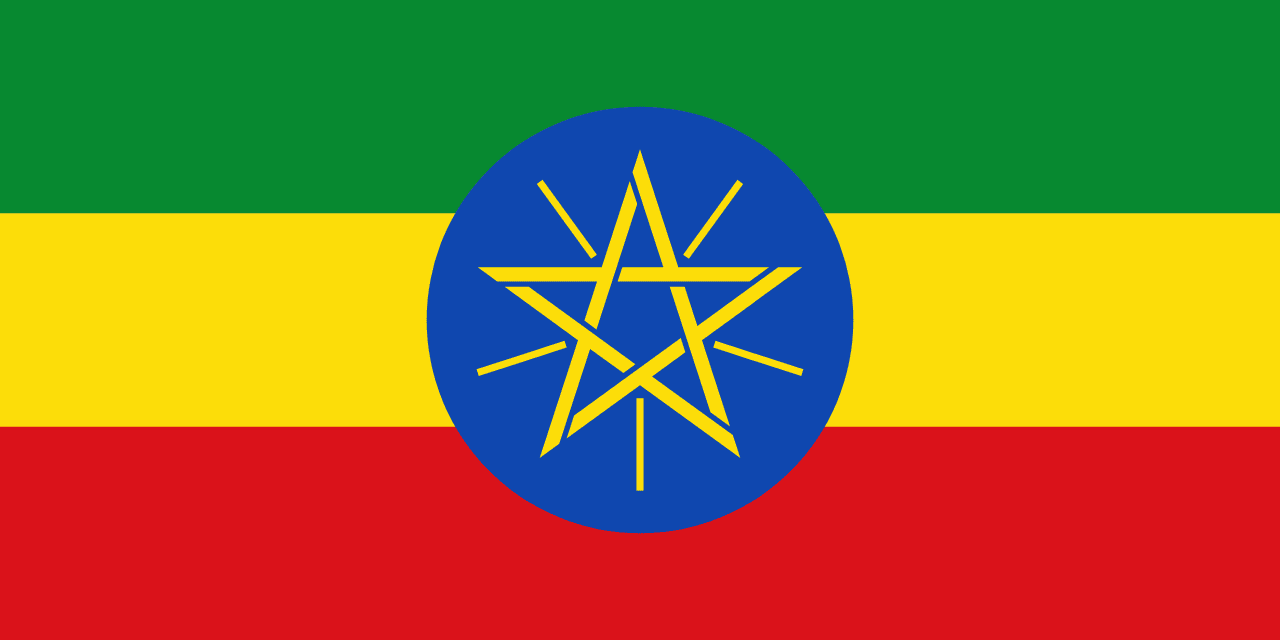La bandera de Esuatini (anteriormente Suazilandia) presenta un diseño llamativo con cinco franjas horizontales: azul, amarillo, rojo (doble ancho), amarillo y azul. En el centro de la franja roja se encuentra un prominente escudo Nguni en blanco y negro colocado horizontalmente, flanqueado por dos lanzas y un bastón adornado con borlas de plumas.
Información sobre Esuatini
| Día de la Bandera Nacional | 6 de septiembre |
| Estado soberano | Sí |
| Nombre oficial | Reino de Esuatini |
| Capital | Mbabane |
| Población | 1.160.164 |
| Área | 17.364 km² |
| Moneda | Lilangeni (SZL) |
| Idioma | Suazi, inglés |
| Continente | África |
| Región | África Meridional |
| Subregión | África Meridional |
| Fronteras | Sudáfrica, Mozambique |
| Zona horaria | Hora Estándar de Sudáfrica (SAST) UTC+2 |
| Código telefónico | +268 |
| Dominio de nivel superior | .sz |
Historia de la bandera de Esuatini
 La bandera fue adoptada oficialmente el 6 de octubre de 1968, coincidiendo con la independencia de Esuatini del dominio colonial británico. Su diseño se inspira en la bandera militar presentada por el Rey Sobhuza II al Cuerpo de Pioneros Suazi en 1941. La bandera ha permanecido sin cambios desde la independencia, incluso después del cambio de nombre del país de Suazilandia a Esuatini en 2018, reflejando la continuidad en la identidad y el simbolismo nacional.
La bandera fue adoptada oficialmente el 6 de octubre de 1968, coincidiendo con la independencia de Esuatini del dominio colonial británico. Su diseño se inspira en la bandera militar presentada por el Rey Sobhuza II al Cuerpo de Pioneros Suazi en 1941. La bandera ha permanecido sin cambios desde la independencia, incluso después del cambio de nombre del país de Suazilandia a Esuatini en 2018, reflejando la continuidad en la identidad y el simbolismo nacional.
Simbolismo y diseño de la bandera de Esuatini
Cada elemento de la bandera de Esuatini tiene un profundo significado simbólico. La franja roja central, del doble de ancho que las demás, representa las batallas libradas por la independencia y la determinación de la nación de defender su soberanía. También simboliza la rica tierra roja de Esuatini, vital para su agricultura. Las franjas azules en la parte superior e inferior simbolizan la paz y la estabilidad, esenciales para el desarrollo y la prosperidad nacional. Las franjas amarillas representan los recursos minerales y naturales del país, particularmente el oro, que ha jugado un papel significativo en la economía de Esuatini.
El escudo Nguni en blanco y negro en el centro es un símbolo tradicional de protección, que representa la defensa de la cultura y los valores nacionales. Las dos lanzas y el bastón simbolizan la protección contra los enemigos del país, mientras que las borlas de plumas representan las tradiciones indígenas y el patrimonio cultural del pueblo suazi.
Uso y significado de la bandera de Esuatini
 La bandera de Esuatini es un poderoso símbolo de identidad nacional, unidad y orgullo. Se exhibe de manera prominente durante las celebraciones nacionales, como el Día de la Independencia el 6 de septiembre, y en ceremonias oficiales y eventos culturales. La bandera ondea en edificios gubernamentales, escuelas y espacios públicos, sirviendo como un recordatorio constante de la soberanía y el patrimonio cultural del país. En foros internacionales y entornos diplomáticos, la bandera representa la posición única de Esuatini como una de las últimas monarquías absolutas del mundo y su compromiso con la preservación de las estructuras de gobierno tradicionales junto con el desarrollo moderno.
La bandera de Esuatini es un poderoso símbolo de identidad nacional, unidad y orgullo. Se exhibe de manera prominente durante las celebraciones nacionales, como el Día de la Independencia el 6 de septiembre, y en ceremonias oficiales y eventos culturales. La bandera ondea en edificios gubernamentales, escuelas y espacios públicos, sirviendo como un recordatorio constante de la soberanía y el patrimonio cultural del país. En foros internacionales y entornos diplomáticos, la bandera representa la posición única de Esuatini como una de las últimas monarquías absolutas del mundo y su compromiso con la preservación de las estructuras de gobierno tradicionales junto con el desarrollo moderno.
Datos interesantes sobre la bandera de Esuatini
- El escudo Nguni en la bandera es un tipo específico utilizado por el pueblo suazi, distinguiéndolo de los escudos utilizados por otros grupos étnicos en la región. Su inclusión destaca la importancia de la guerra tradicional y la defensa en la cultura suazi.
- Esuatini es una de las pocas monarquías absolutas que quedan en el mundo, donde el rey, conocido como Ngwenyama (León), tiene un poder político y ceremonial significativo. El diseño de la bandera refleja esta estructura única de gobierno y la importancia de las tradiciones reales.
- La bandera experimentó modificaciones menores en 1981 para estandarizar sus proporciones y asegurar una representación consistente. Esto incluyó ajustar el tamaño y la ubicación del escudo y las armas para una mejor visibilidad.
- A pesar del cambio de nombre de Esuatini en 2018, la bandera permaneció sin cambios, enfatizando la continuidad en el simbolismo y la identidad nacional. Esta decisión refleja el equilibrio entre honrar las tradiciones y abrazar el cambio en la sociedad suazi.
- La combinación de colores rojo, amarillo y azul es relativamente poco común entre las banderas africanas, lo que hace que la bandera de Esuatini sea particularmente distintiva y fácilmente reconocible en entornos internacionales.





